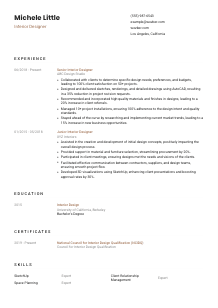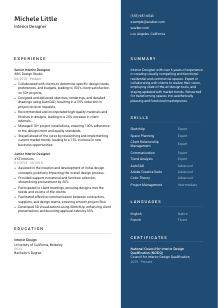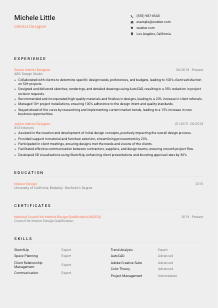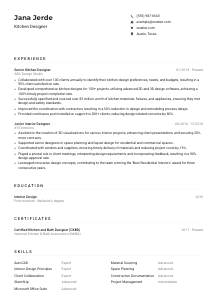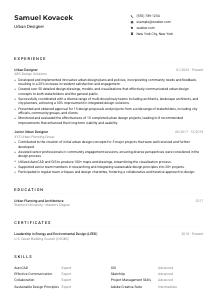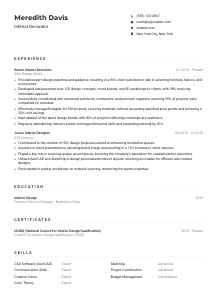Interior Designer Resume Example
Shaping spaces, but your resume feels boxed in? Unfold your potential with this Interior Designer resume example, styled using Wozber free resume builder. See how to layer your aesthetic touch to match job specifications, turning your career canvas into a room filled with opportunities!
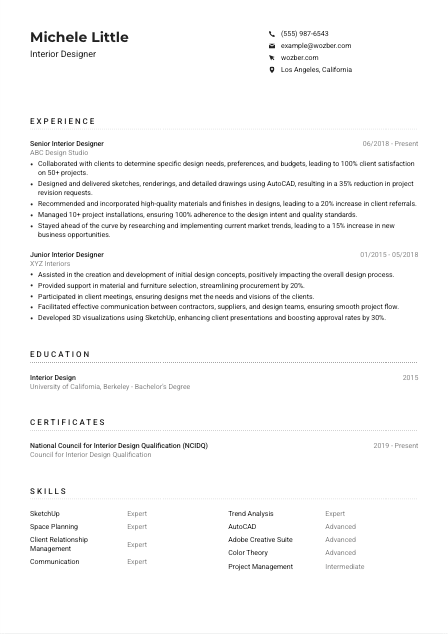
How to write an Interior Designer resume?
Hello, visionary Interior Designer! If transforming spaces into breathtaking habitats is your passion, then crafting an equally compelling resume should be your next project. The stakes in the interior design job market are high, and standing out is not just an option—it's a necessity. With the right approach, your resume can be a luminous showcase of your creativity and professionalism.
Utilizing the free resume builder by Wozber, this guide will inspire you to tailor your resume with precision, ensuring it resonates with your dream Interior Designer role. Ready to weave your professional narrative into a job-winning masterpiece? Let's paint a path to success together.
Personal Details
Think of the Personal Details section as the foyer of your resume—your first opportunity to make a memorable impression. Tailoring this section for the Interior Designer position involves more than just listing contact information; it's about presenting yourself as a detail-oriented professional right from the start.
1. Showcase Your Name with Flair
Your name is the marquee of your professional persona. Ensure it's prominently displayed, perhaps with an eye-catching font that stays professional. This subtle touch introduces your design sensibility from the outset.
2. Mirror Your Professional Title
"Interior Designer"—seeing this title beneath your name instantly aligns your identity with your professional pursuit, creating a seamless connection in the hiring manager's mind.
3. Ensure Your Contact Details Sparkle
Including a phone number and a professional email address is a must. But don't overlook the power of a well-maintained LinkedIn profile or portfolio website, showcasing your projects and echoing your resume's highlights.
4. Location, Location, Location
Stating "Los Angeles, California" not only matches the job requirement but also reassures the hiring manager of your logistical fit for the role. This detail can be a deciding factor in landing an interview.
5. Edit Out the Extras
Save space by skipping personal details that don't serve your professional narrative. In the world of design, let your work and experiences speak louder than words.
Takeaway
The Personal Details section is the handshake before the conversation—professional and poised to impress. Craft it with the same attention to detail you would apply to a design project, setting the tone for a resume that resonates with your desired Interior Designer role.





Experience
Your experience section is like the portfolio of your resume, showcasing your most impactful design projects. Tailoring this section to reflect the interior design role you're after involves strategic storytelling and a keen eye for detail.
- Collaborated with clients to determine specific design needs, preferences, and budgets, leading to 100% client satisfaction on 50+ projects.
- Designed and delivered sketches, renderings, and detailed drawings using AutoCAD, resulting in a 35% reduction in project revision requests.
- Recommended and incorporated high‑quality materials and finishes in designs, leading to a 20% increase in client referrals.
- Managed 10+ project installations, ensuring 100% adherence to the design intent and quality standards.
- Stayed ahead of the curve by researching and implementing current market trends, leading to a 15% increase in new business opportunities.
- Assisted in the creation and development of initial design concepts, positively impacting the overall design process.
- Provided support in material and furniture selection, streamlining procurement by 20%.
- Participated in client meetings, ensuring designs met the needs and visions of the clients.
- Facilitated effective communication between contractors, suppliers, and design teams, ensuring smooth project flow.
- Developed 3D visualizations using SketchUp, enhancing client presentations and boosting approval rates by 30%.
1. Lay the Foundation
Scrutinize the job description and underline keywords and phrases. For this role, phrases like "collaborated with clients" and "recommended materials, finishes, and furniture" are your guiding lights.
2. Structuring Your Design Legacy
Organize your experience in reverse-chronological order, providing context with company names and employment dates. This will narrate your professional growth and adaptability in the design arena.
3. Sketch Your Achievements
Write accomplishment statements that reflect the job requirements, such as reducing project revision requests by employing AutoCAD and SketchUp or enhancing client satisfaction through bespoke design solutions.
4. Paint with Numbers
Quantify your successes wherever possible. If you've increased client referrals by a certain percentage or managed a notable number of projects, highlight these achievements. Numbers draw attention and provide a clear measure of your impact.
5. Curate with Care
Resist the temptation to list every project you've ever worked on. Focus on the experiences that best match the job description. Remember, like a well-designed room, each element of your resume should serve a purpose.
Takeaway
Approach your Experience section as a curated collection of your career highlights. Each bullet point is a vignette of your professional journey, perfectly positioned to capture the hiring manager's attention. With the right mix of achievements and precision, your experience will narrate a story of undeniable talent and potential.
Education
In the realm of Interior Design, your educational background not only reflects your foundational knowledge but also your dedication to your craft. Tailoring your education section means highlighting the aspects most aligned with the expectations of your dream role.
1. Degree Specifications
If the job description champions a specific educational background, like a "Bachelor's degree in Interior Design," make sure it's the first thing mentioned under your education section.
2. Keep it Crisp and Clear
Structure this section for quick readability: Degree first, followed by the field of study, institution, and graduation date. This format speaks to your organizational skills—a must-have for any designer.
3. Align Your Degree
When your degree directly matches the job listing, it's like lighting in design—absolutely crucial. Ensure it's accurately listed, reflecting both the discipline and the level attained.
4. Exhibit Relevant Courses or Projects
For newer grads or those looking to emphasize specific skills, listing relevant coursework or projects can add depth to your educational narrative, showcasing your relevant training and initiative.
5. Accentuate Other Academic Achievements
Were you part of an interior design association at university? Did you take top honors in a design competition? These details can add layers to your profile, showing a commitment to your field beyond the classroom.
Takeaway
Think of your education section as the foundation of your design philosophy—solid, thoughtfully structured, and reflective of your journey. Tailor it to resonate with the Interior Designer role you aspire to, showcasing not just your qualifications but your passion and dedication to the craft.
Certificates
In the fast-evolving field of interior design, certificates act as badges of continuous learning and specialization. Tailoring this section means selecting certifications that not only meet the job requirements but also elevate your candidacy.
1. Identify the Hallmarks
Start with the job requirements. In this case, "Possession of NCIDQ certification" stands out. If you have this certification, it's your golden ticket—make sure it's front and center.
2. Showcase Your Specializations
Focus on certifications that speak directly to the job's core needs. This not only shows your commitment to your field but also your readiness to meet the specific demands of the role.
3. Mark the Milestones
For certifications with a validity period or recent achievements, adding dates showcases your up-to-date expertise and ongoing commitment to professional development.
4. Pursue Growth
The design world never stands still, and neither should you. Regularly seek out certifications that align with your career goals and current industry trends, ensuring you're always at the forefront of your field.
Takeaway
Treat the Certificates section as a gallery of your professional growth and dedication. Highlighting relevant certifications not only underscores your qualifications but also signals to hiring managers your continual pursuit of excellence. Always be strategic and selective, prioritizing certifications that provide the most value to your Interior Designer resume.
Skills
The Skills section is the swatch book of your resume, offering a colorful glimpse into your professional toolkit. Here, the goal is to align your proficiencies with the job description, creating a compelling and relevant narrative.
1. Sift Through the Requirements
Dive into the job listing to pick out essential skills—"Proficient in AutoCAD, SketchUp, and Adobe Creative Suite" are explicitly stated and should be among the first skills you list.
2. Highlight Your Palette
Beyond the hard skills, don't forget to showcase your soft skills. Strong "communication and client relationship management skills" are crucial in this role, blending your technical expertise with the softer shades of your professional personality.
3. Organize for Impact
Keep your skills list concise and focused. Prioritize those that the job description emphasizes, ensuring the hiring manager can quickly paint a picture of you as the ideal candidate.
Takeaway
Curate your Skills section with the precision of an artist selecting their materials. This concise, impactful list should convince the hiring manager of your suitability at a glance, blending hard and soft skills into a compelling overview of your professional capabilities.
Languages
In a field as expansive as interior design, language skills can be the distinctive accent that sets your resume apart. Tailoring this section revolves around emphasizing linguistic strengths that could benefit your role, particularly in a diverse city like Los Angeles.
1. Evaluate the Linguistic Landscape
Given the job's location and clientele, your proficiency in "English" and any additional languages can enhance your appeal, suggesting an ability to engage with a broader client base effectively.
2. Prioritize Pertinent Languages
Always start with the languages the job description highlights. In this case, "Must be conversant in English." Any additional languages should complement your primary linguistic capability.
3. Display Your Diversity
Being fluent in other languages, such as French, showcases your ability to communicate in a multicultural environment, an invaluable asset in the globally-influenced world of interior design.
4. Clarity in Proficiency
Use straightforward terms to describe your proficiency levels—ranging from 'Native' to 'Basic.' This clarity provides a clear understanding of your communication capabilities.
5. Reflect on the Role's Demands
While language skills are always a plus, they're particularly valuable in roles that involve diverse client interactions or collaborations abroad. Highlighting your multilingual abilities can attest to your adaptability and cultural sensitivity.
Takeaway
Your language abilities are like the finishing touches on a well-designed space—potentially transformative. Flaunt them with confidence, understanding that each language you speak opens doors to new markets, cultures, and opportunities. Remember, in the realm of interior design, communication is as much about listening as it is about speaking. Let your linguistic talents showcase your readiness to engage with the world.
Summary
Your resume summary is like the grand entrance to a well-designed home, setting the tone for what's inside. Crafting this section to match the Interior Designer position you're eyeing requires a blend of creativity and clarity, ensuring you capture the hiring manager's imagination right from the start.
1. Draw the Blueprint
Begin with an overarching statement that captures your professional essence. Mentioning over 6 years of experience immediately signals your seasoned expertise in the field.
2. Decorate with Your Skills
Weave in key skills that align with the job description. Phrases like "Expert in collaborating with clients and employing state-of-the-art design tools" directly reflect the sought-after qualifications.
3. Highlight Your Distinctive Features
Detail a standout achievement or unique aspect of your career. For instance, transforming spaces into aesthetically pleasing environments mirrors the job's responsibilities and your capacity to fulfill them.
4. Apply a Finishing Touch
Keep your summary polished and concise. It's your moment to shine, but resist the urge to overdecorate. A few well-chosen words can make a more memorable impact than a cluttered narrative.
Takeaway
Craft your resume summary with the care of an Interior Designer planning the focal point of a room. It's your chance to compel and captivate, ensuring the hiring manager is eager to explore the depths of your professional portfolio. Make it reflective of your unique style and attuned to the demands of the position. With this in hand, you're not just applying for a job; you're inviting the hiring manager into your professional world, demonstrating that you're the perfect designer to enhance their team's aesthetic and functional aspirations.
Launching Your Interior Designer Journey
Congratulations, you've now journeyed through the essential steps to crafting an ATS-compliant resume tailored to the Interior Designer role. Your resume is more than a document; it's a curated exhibition of your skills, experiences, and aspirations. With Wozber's free resume builder, ATS-friendly resume templates, and ATS resume scanner, you're equipped to create a resume that not only passes technical screenings but also captivates human readers. Embrace this guide as your compass in the competitive landscape of interior design careers.
Your creativity, vision, and now, your resume, set you apart as not just a candidate, but as a designer ready to shape the world. The canvas of your career awaits—paint boldly.

- Bachelor's degree in Interior Design or related field.
- Minimum of 5 years of experience in residential or commercial interior design.
- Proficient in AutoCAD, SketchUp, and Adobe Creative Suite.
- Strong communication and client relationship management skills.
- Possession of NCIDQ certification or willingness to obtain within the first year of employment.
- Must be conversant in English.
- Must be located in Los Angeles, California.
- Collaborate with clients to determine their needs, preferences, and budget to create a comprehensive design plan.
- Prepare sketches, renderings, and detailed drawings using design software.
- Recommend materials, finishes, and furniture, ensuring designs align with client's vision and functional needs.
- Manage and oversee project installations, ensuring adherence to the design intent and quality standards.
- Stay current with market trends, materials, and new products to provide the best solutions for clients.





